|
|
In this section, we will be examining the
processes used to grow a tree over a rock (in the root-over-rock style) and create quite
an effective bonsai. In this example, we will use Ficus Microcarpa over a Japanese
Ibigawa Rock.
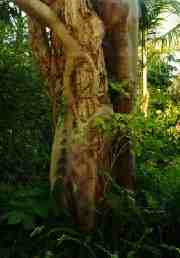 Bonsai is an art which in many ways (according to the artist's perception) tries to mimic
the sights and processes seen in nature. To follow this, the 'root over rock' style has been
widely used in bonsai. This is when the roots of a plant are made to 'cling' to and grasp a
rock - spilling over it and eventually disappearing into the soil. This is to mimic when a
tree has started growing in a small rock crevice (the seed usually deposited by birds) and
has to use its roots to 'venture out' and find more nutrients once its major source has been
depleted. As soon as the roots reach soil, they harden up and grow 'around' the rock - the
roots now acting effectively as the tree's trunk.
Bonsai is an art which in many ways (according to the artist's perception) tries to mimic
the sights and processes seen in nature. To follow this, the 'root over rock' style has been
widely used in bonsai. This is when the roots of a plant are made to 'cling' to and grasp a
rock - spilling over it and eventually disappearing into the soil. This is to mimic when a
tree has started growing in a small rock crevice (the seed usually deposited by birds) and
has to use its roots to 'venture out' and find more nutrients once its major source has been
depleted. As soon as the roots reach soil, they harden up and grow 'around' the rock - the
roots now acting effectively as the tree's trunk.Another instance of this happening in
nature is when a tree actually starts growing on another and eventually overpowers its host
by 'strangling it' with its roots.
This can be seen in the above photo, where
a young strangling fig sends its roots down a paperbark tree into the soil to search for more
nutrients. Because figs are so tenacious and very well suited to the 'root over rock'
style - I will use that species for this example. | |
The first step for a 'root
on rock' style is to prepare the subjects. Both the plant and rock are important - so choose a
suitable rock for this planting that looks appealing, attractive, natural and is a suitable size
- but doesn't overpower the tree.
A fig will be used, so choose one that looks healthy and that has an extensive
root system. What is essentially needed is a plant which has long, tough roots that you can
'drape' over the rock when you position it to create the effect that the roots have grown over
and down it. If the plant does not have a very long root system (at least one and a half times
the height of the rock you have chosen), plant the tree in a tall, yet thin pot to encourage
the roots to grow downwards. A sawn off PVC pipe can even be used - as long as the correct
alterations have been made. Grow the tree for a year or so, until the roots have grown long
enough.
Materials needed : Suitable Rock (Japanese Ibigawa Rock); Plant suited to root
over rock style (Ficus Microcarpa); Plastic Grafting Tape; Scissors; Concave Branch Cutters;
Bonsai Secateurs; Knife; Root Hook/Fork; Clean, Sharp Sand. (1) Once the roots are long enough,
cut off all unsightly or unnecessary foliage and wash as much soil as possible away from the
root ball of the plant - taking care not to damage the roots. (Try to remove as much soil
possible by hand first - and then wash with a standard garden hose).
(2) Next, take your chosen rock and your plant and place the plant over the
rock. From here, experiment, and see what arrangement looks best. Try to not place all of the
roots to one side, as a bonsai should be able to be viewed from all directions. Find the
interesting crevices, nooks and crannies of the rock and implement the roots of the plant
into these - to make the finished bonsai look as natural as possible. You can even 'overlap'
thin, undeveloped roots, which, if left long enough, will merge together.(3)
The next step is to set the roots in place. Although there are many methods - using grafting
tape in my opinion is the easiest and most effective. (It is best to do this with an assistant).
With one person holding the roots in place, wrap the grafting tape around the rock reasonably
tightly, making sure to cover it completely except for the bottom, were the roots will protrude
into the soil. Also make sure that there are no areas where roots can escape from gaps in the
grafting tape where they are not supposed to be.(4) After the roots have
been set in place - making sure that all of the roots protrude from the bottom of the rock -
bury it with the plant in a pot of clean, sharp sand. It should be planted so that no part of
the rock is visible and the bottom part of the trunk of the tree is visible.(5)
Now thoroughly water the bonsai - leaving it in the pot for one to two years. Although the roots
may seem small and weak now, in just one growing season they will really thicken up, and if you
have placed them right - produce a really great show.
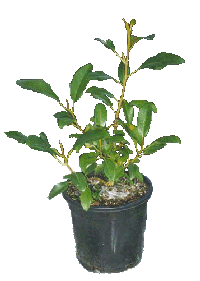
(6)Here is the fig I used growing in a large pot after having been trained to
grow over the rock (under the soil) for a period of 2 years. I usually leave figs growing for
two years - just so the roots can really thicken up and attach themselves to the rock. If the
plant is fast growing (or you're just impatient!) it is possible just to leave it for
one year. If you do happen to take the plant out of the soil and see that it hasn't really
developed properly, you can just repot it back for another year. |
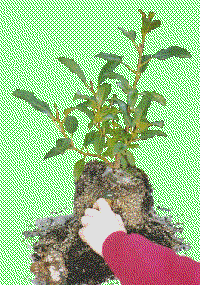 (7)Once the pot is taken
away, the soil is removed by scraping and then washing, to expose the rock and rootball.
Still try to be gentile so that you don't damage any of the established or newly formed roots
as this will cause quite a lot of undue stress to the plant. |
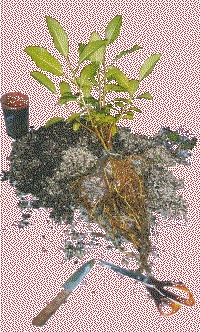 (8)Here we see the roots, which were bound to the rock
by means of grafting tape. The lower roots were allowed to come out the bottom of the grafting
tape. | 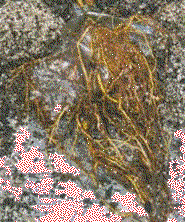 You can see where there have been
weaknesses in the grafting tape and roots have escaped. This is why it is important to wrap the
grafting tape tightly. Unfortunately, the shape of this rock did not make that task any
easier... You can see where there have been
weaknesses in the grafting tape and roots have escaped. This is why it is important to wrap the
grafting tape tightly. Unfortunately, the shape of this rock did not make that task any
easier... |
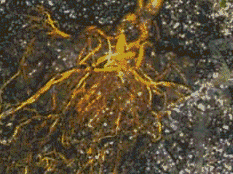 (9)Next, remove the grafting tape with a pair of sharp scissors -
taking care not to cut through the roots. Here we see the exposed roots and rock with the
grafting tape removed. After a period of 2 years, the roots have well and truly
bonded themselves to the rock in quite an attractive way. These roots have also grown
considerably and will be exposed as the 'lower trunk' of the bonsai when potted up into a
ceramic dish. |
(10)For the meantime, pot the fig back into a
plastic pot with the rock above the surface to allow it to rejuvenate. Leave it for a few
months. (11)Now, choose a suitable ceramic bonsai pot in which to display your
newly formed bonsai. Root over rock style bonsai works particularly well with shallow, oval
pots. The colour of pot that I will choose for this bonsai will be one that complements its
natural, subtle colours. I might choose an unglazed brown pot, or a light green one that
matches its leaves.
'Finished' Bonsai :
 Here is the finished bonsai -
Ficus Microcarpa growing artistically over Japanese Ibigawa rock (picture 1). Here is the finished bonsai -
Ficus Microcarpa growing artistically over Japanese Ibigawa rock (picture 1).
This arrangement looks very attractive placed in this blue-green glazed oval dish which
perfectly compliments the natural tones of the fig. Placing the plant to the dish's left
opposed to the center - which is an artificial placement - further enhances the natural
effect that I was trying to achieve. 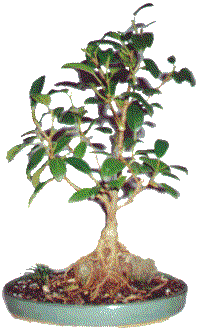
At the time of potting, the bonsai currently does not resemble a tree very
much - being quite bushy and out of proportion to how figs would normally grow, so it must be pruned further back to encourage trunk taper, a tree-like appearance, and to refine the
branch structure. Six months later, the fig was cut back further to re-establish
its natural tree-like shape (picture 2). The left lower branch was removed, and trunk (which was allowed
to grow larger than usual to help the tree establish itself and broaden the lower trunk) was
also chopped. Now we must allow the tree to grow back and keep re-shaping until the
desired form is reached. The third picture (and the large tree pictured) was taken 2 years after the
tree was first taken out of its training pot. Overall, 'root over rock' is a very effective and
aesthetically appealing style, which mimics how figs and other plants grow in the wild.
It is considered an advanced style, although is not too difficult to achieve with a bit of
practice and the right materials. |
|